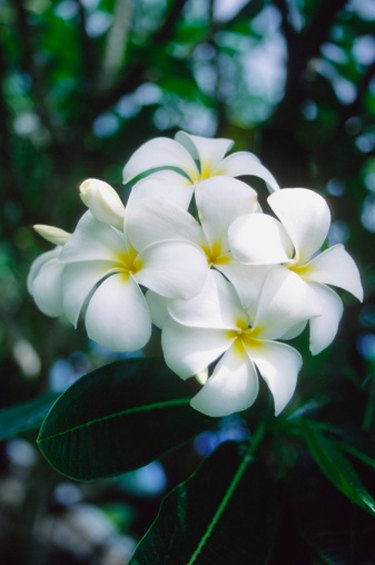
Plumeria, also called frangipani, are tropical trees prized for their highly fragrant flowers. One way plumeria trees are successfully grown in non-tropical areas is by keeping them in pots and protecting them indoors in the winter. Pots that are too small can slow or even stunt a plumeria's growth, so it's good to know when to repot a plumeria to keep it healthy and full with aromatic blooms each year.
Trees Emerging from Dormancy
Video of the Day
In the fall, this tree goes dormant in non-tropical climates, even to the point of losing all its leaves. Even though it looks almost like a dead stick in dormancy, the plumeria bounces back when temperatures warm up. The best time to repot a plumeria is in the spring, when the temperature is constantly above 50 degrees Fahrenheit, and right before the tree goes into a major growth transformation. Repotting too long after this interrupts the appearance of flowers or cause any flowers present to fall off.
Video of the Day
Rooted Cuttings Need a New Pot
Another good is time to repot a plumeria is after the cutting has rooted. Plumeria cuttings get waterlogged and rot easily, so they are best started in sterile or sandy soil with very little water and no nutrients. Once the root system is established, the tree needs nourishment to continue to grow. Transferring to a 3- or 4-inch pot at this time ensures a vigorous start for the new plant.
Roots Outgrow Their Pot
A surefire way to know when to repot a plumeria is when the roots are coming out of the holes in the bottom of the pot. When a plant has overgrown its container, the roots try to reach new soil and nutrients any way it can. The plumeria is no different from any other plant in this way. When roots are coming through the bottom of the pot, it is time to replace the pot. A plumeria is a tree and requires a lot of soil and moisture to survive, so watch and listen to what the roots are telling you.
Yearly Repotting
In general, plumeria should be repotted yearly up to the next pot size. The Plumeria Society of America recommends 1 gallon for every foot of stalk or trunk. Standard black, plastic nursery pots are recommended over clay. Plumeria need lots of water and, in certain climates, clay or terra cotta dry out too easily. Also, if the root ball gets too compacted in clay pots, the roots can be damaged during repotting.